Table of Contents
Introduction
I am sure that almost everyone reading this post would be aware of what Earthquakes are. But, most of you would not have a basic idea of how Earthquakes happen. But, don’t worry, we will unravel the basics and some Geology around the Earthquakes in this post. This post will help both the unaware and the curious ones.
In layman’s terms, an Earthquake can simply be defined as a shaking of the ground/Earth. Earthquakes can be mild or highly intense and can lead to destruction and loss of lives. In case of damage to the environment (houses, buildings, roads, etc.), and if people get killed, the Earthquake is considered a natural disaster. It can be as devastating as Cyclones, Tsunamis, etc.
Over the years, we have heard of many accounts where people have died and the cities have been destroyed due to Earthquakes. Thus, we should know what they are. How and why do Earthquakes happen? How are they measured? And, what we should do in case of an earthquake?
We will answer all the above questions in a very simple way in this post.
Anatomy of Earth
To decipher and understand what Earthquakes are, a basic knowledge of different layers of Earth would be a good starting point.
Our Earth majorly consists of 3 layers:
- Core (Inner and Outer Core)
- Mantle
- Crust
The “Core” layer of the Earth consists of an Inner core and an Outer core. We will discuss both of them along with the other layers – Mantle and Crust. Refer to Image 1 for all the layers discussed in the section below.
It is not necessary to have in-depth knowledge of these layers for a basic overview of Earthquakes and how they happen. I have incorporated brief information about the layers out of curiosity. It is limited and simple to grasp.
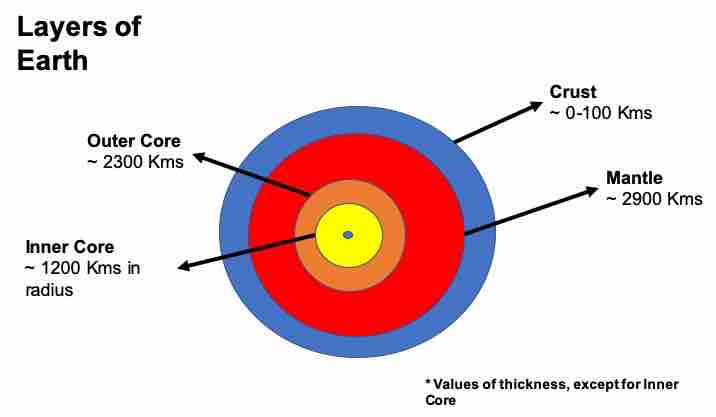
Image 1 – The four layers of Earth
Inner Core
The Inner Core or the Solid Inner core is the first layer around the center of the Earth. It is primarily made up of Iron and Nickle with a radius of about 1,200 kilometers. Other elements like gold, silver, etc. are also part of this layer. The temperature of the inner core is expected to be very high spiking up to 5,400 degrees Celsius. The pressure at this layer is so high that even after such high temperatures, it is solid.
Outer Core
The Outer Core or Outer Liquid Core lies between the Inner Core and Mantle. It largely consists of Iron and Nickle but in liquid form. The thickness of this layer is expected to be around 2,300 kilometers. The temperature of this core is also high and is expected to range between 4,000 & 5,000 degrees Celsius and more. The core though has a high temperature but does not have a high enough pressure to turn it into a solid form.
Mantle
The mantle is considered to be the thickest layer of the Earth stretching up to almost 3,000 kilometers (2890 Kilometers as derived.) It is also considered to form the majority of the Earth’s volume. The layer is semi-solid and consists of rocks rich in Iron, Silicon, and Magnesium. The temperature of this layer can rise to 4,000 degrees Celsius.
Crust
This layer of Earth concerns us when we talk about Earthquakes. The Crust is the outermost layer of the Earth above the Mantle. It consists of many elements like Oxygen, Silicon, Aluminum, Iron, Calcium, Potassium, and Magnesium. The thickness of the Crust is variable and can extend from tens to a few hundreds of kilometers. Generally, it is expected to be within 100 kilometers.
The distance between the Earth’s surface and its center stretches to around 6371 kilometers on average (average because Earth is not exactly a sphere, but more of a spheroid.) There is a slight difference (around 22 kilometers.) between the distance from the Equator to the center of the earth and that from the Poles to the center of the Earth, with the distance from the Equator being a bit more than that from the Poles.
Till now, humans have only been able to drill down to a maximum of around 12 kilometers into the Earth’s surface.
What are the Tectonic Plates?
As stated earlier, Earthquakes are related to the Crust layer of the Earth. This layer however is not in one piece around the globe. It is made up of multiple big chunks just like multiple pieces in a jigsaw puzzle. These big chunks/pieces of Crust are called Tectonic Plates (Refer to Image 2 where the blocks of Earth are shown). The Tectonic Plates are considered to encapsulate the Crust and the upper layer of the Mantle.
The tectonic plates move slowly (apparently due to convection currents inside the layers of the Earth. We will not get into the Physics of it.) This movement is only a few centimeters per year and the movement rate can vary for different plates. The border between two Tectonic plates is called a Plate Boundary. Our globe is divided into multiple Tectonic Plates. There are a few major plates and many minor plates.
Different types of Plate Boundaries
Tectonic Plate movement causes natural phenomena like Volcanic activity, Earthquakes, Crust deformation, etc. There are 3 different kinds of Plate Boundaries that can cause Earthquakes. Let us go through them.
Transform Boundary
The locations where the Tectonic Plates slide past each other are called Transform boundaries. When the plates slide, Earthquakes can occur due to the release of energy. Earthquakes can happen both underwater and on land. We will discuss more on this type in the sections below. Refer to Image 3.
Divergent Boundary
The locations where the two Tectonic Plates move apart or away from each other, we call them as Divergent boundaries. Apparently, as a result of this movement, the magma or molten rock rises from the Mantle and solidifies to create a new crust. Earthquakes can happen in this scenario. Ocean basins and rift valleys could form as a result of this movement. This boundary is also called Constructive Plate Boundary as it creates new crust. Refer to Image 4.
Convergent Boundary
The locations where the Tectonic Plates move towards each other are called Convergent boundaries. In this case, the thinner and more dense plate is overridden by the thicker and less dense plate. The outcomes are volcanic activities, earthquakes, and crust deformation. We will discuss more on this type in the sections below. Refer to Image 5.
What is an Earthquake?
An Earthquake is a phenomenon of shaking or trembling of the Earth’s surface when the Tectonic Plates slip past, move apart, or collide with one another. So, Earthquakes happen because of the activity between the Tectonic Plates. The Earthquakes lead to the creation of Seismic waves that cause the tremors and shaking of the Earth’s surface.
Seismic waves are like waves of energy that are released due to the activity between Plate Boundaries and cause Earthquakes. These waves are also used to study Earthquakes.
There are mainly three types of Seismic waves, Primary, Secondary, and Surface. The Primary waves travel the fastest.
What are faults and how do Earthquakes happen?
Now that we have an idea about Crust layer, Tectonic plates, and Plate boundaries, we can focus on why and how Earthquakes happen.
Faults
The faults are the regions where Earthquakes mostly happen. The faults are created along the Tectonic Plate boundary and in the Crust layer of the Earth. They are like fractures in the Earth’s Crust. The plane is called the Fault Plane where the faults occur. There are 3 types of faults and each of them is associated with a Plate Boundary and thus to a particular Earthquake type. We will introduce the terms in the sections below.
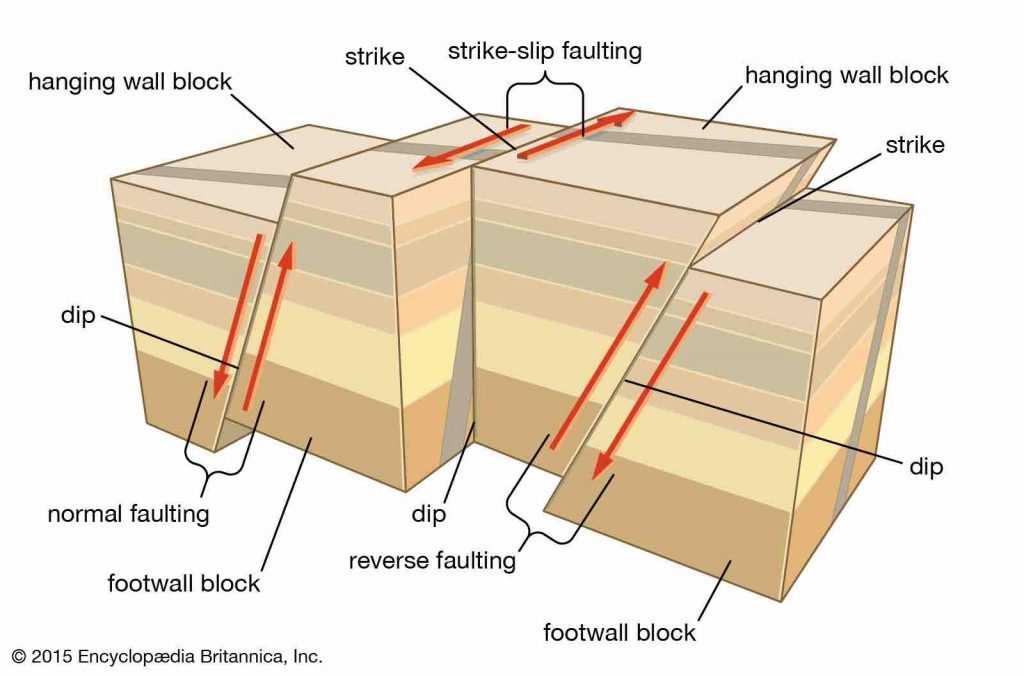
Image 2 – Summary of Faults around the Tectonic plates
Focus and Epicenter
The other terms that relate to earthquakes are Focus and Epicenter. The Focus of an Earthquake is the point on the Fault plane from where the Seismic waves are released. Focus is also called the Hypocenter. It is considered to be inside the Crust and the point where the Earthquake starts.
The point directly above the Focus or Hypocenter on the surface of Earth is called Epicenter. This is considered to be the first point on the surface of Earth to experience the tremors.
Refer Images 3, 4, and 5 for Epicenter and Hypocenters
Let us now look at the different types of Earthquakes and how they happen based on boundaries and faults.
Earthquakes due to Transform Boundary
In the Transform boundary, the Tectonic Plates are considered to move in the opposite direction.
When the Tectonic Plates move in the opposite direction, there can be locations where the plates can slide past each other. Due to the stress, faults are created leading to rough edges at the plate boundaries where the slide motion happens.
A block/chunk of rock is created on either side of the fault. This type of fault is called Strike-slip fault, where the Tectonic Plates slip past through in a horizontal direction.
When the blocks of rock move and slide past each other, the blocks often get stuck due to the rough surface while the other part of the plates keeps moving. The energy that otherwise helps in the movement of the plates gets stored over time and the force keeps on building up. Once the force exceeds the friction, the blocks are able to slip past each other. A vast amount of energy is released in this process leading to the Earthquake and the tremors.
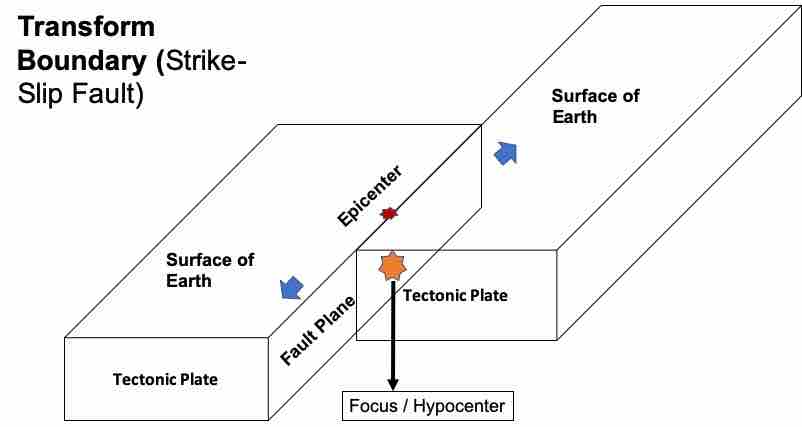
Image 3 – Transform Boundary, Strike-Slip Fault, Epicentre, and Hypocenter
Earthquakes due to Divergent Boundary
In the case of Divergent boundary, the Tectonic Plates move away/apart from each other at the plate boundaries. Here, the Earth’s Crust gets broken and the magma from the Mantle rises and cools down creating a new Crust.
In this motion, the fractures or faults are created where the Crust starts to separate. Such faults are known as Normal Faults. The Crust on one side of the fault often moves down. The block that remains intact is called Footwall, while the block that slips is called the Hangingwall. Earthquakes can result where the fracture happens as a huge amount of energy is released when the Crust breaks and moves.
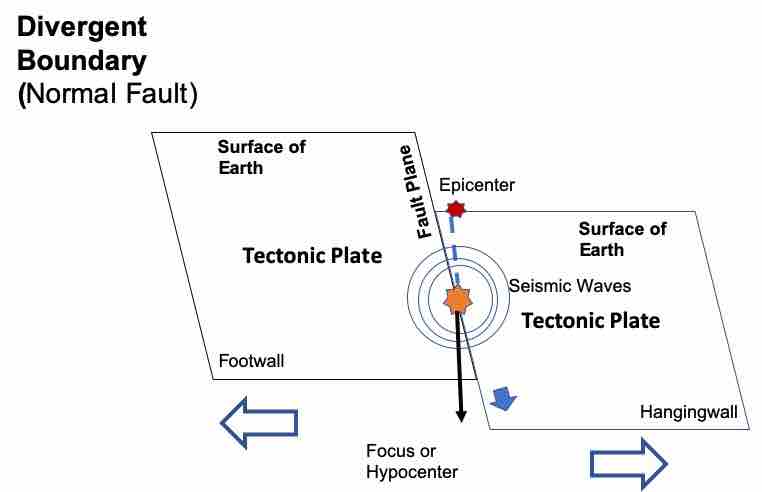
Image 4 – Divergent Boundary, Normal Fault, Epicentre, and Hypocenter
Earthquakes due to Convergent Boundary
In the case of Convergent boundary, the Tectonic Plates move toward each other at the boundaries and collide or bump. The convergent boundary is associated with when one of the Plates moves up relative to the other Plate. Or, one of the Plates is subducted below the other plate. This boundary type is also called Destructive Plate Boundary as part of the plates gets destroyed. The fault created here is called a Reverse Fault (Crust on one side of this fault moves up relative to the other and the movement is vertical.)
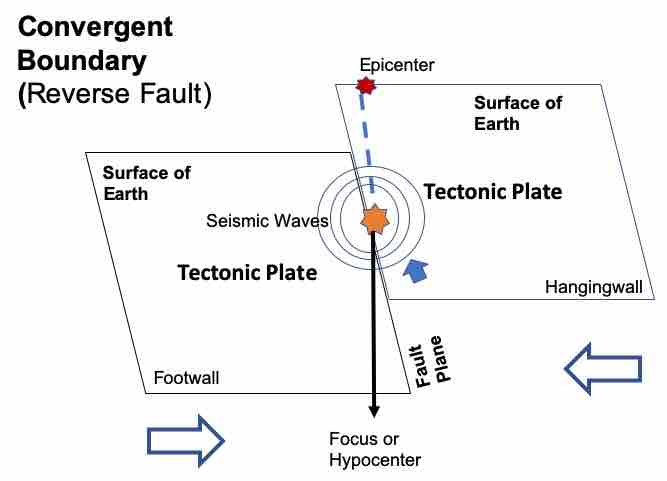
Image 5 – Convergent Boundary, Reverse Fault, Epicentre, and Hypocenter
When we talk about Earthquakes related to Convergent Boundary or Destructive Plate Boundary, we are referring to the movement between the Oceanic Plate and Continental plate. In this case, the Oceanic plate gets subducted or pushed down under the Continental plate. Earthquakes can occur at the interface of plate boundaries.
There can be another scenario where two Continental Plates collide with one other. Since there is not much of density difference between the two plates, the boundaries collide, crumble, and push up. This phenomenon causes the formation of Mountains and can also cause Earthquakes.
It has been observed that most of the Earthquakes and also the most powerful Earthquakes happen due to Convergent Boundaries or where the subduction happens.
Divergent Boundary (Normal Fault) can be related to gravity where one side of the fault moves below relative to the other side, just like a gravitational pull.
Convergent Boundary (Reverse Fault) can be now related to the opposite of the gravitational pull where one side of the fault moves up relative to the other.
How can we measure Earthquakes?
An Earthquake’s magnitude is measured on the Richter Scale with values between 1-10. An Earthquake that is measured 1-2 on the Richter Scale is considered to be very small and sometimes even goes unnoticed. Earthquakes having a magnitude of 7 and above are powerful and can cause great destruction.
When Earthquakes happen, the seismic waves are measured using a device called Seismometer or Seismograph (Seismometer is a part of Seismograph, but they are used interchangeably.) The Seismometer produces a Seismogram using which the Earthquakes are measured.
In very simple terms, a Seismograph contains a plotting surface (like paper) that lies horizontally to the Earth’s motion, a large object, and a plotting device added to the large object. As the Earth shakes due to an Earthquake, the plotting surface also moves but not the large object, and the plotting device plots the ground movement. The plot captures the displacement of the ground over the period of the Earthquake.
Earlier, one of the main challenges in recording Earthquakes was that if the Earth moved or shook, the Seismograph also moved. Thus, a Seismograph is tightly coupled to the bedrock and a large mass object is used that will not move relative to the Earth’s movement.
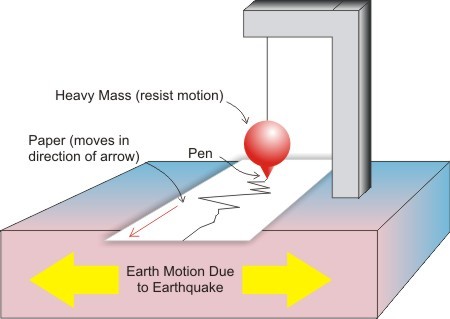
Image 6 – Seismograph & Seismogram Model (Picture Courtesy – azosensors.com)
Using the above technique, almost every time, the Seismogram captured by the Seismograph was not visible enough to relay any information. Thus, different techniques and mechanics were deployed to magnify the plots or Seismograms, so that even the smallest of Earthquakes can be captured with distinct data.
With technological advancement, better Seismographs have come up. Today, amplified Seismograms can be easily recorded electronically.
Important Points
Three or more Seismographs are used to determine the Epicenter of an Earthquake.
A scale called Moment Magnitude Scale (Mw) is widely used today to measure Earthquakes. This scale has advantages over the old Richter scale. Mw provides the most accurate information about the different range of Earthquakes.
If we have an earthquake having a magnitude of 4 and another one having a magnitude of 5, the difference though may seem to be only 1, the Earthquake with a magnitude of 5 can be multiple folds more powerful than the one with a magnitude of 4.
A few statistics on Earthquakes
Let us look at some of the statistics around different magnitudes of earthquakes, frequency, effects, and their categories.
| Magnitude (Richter Scale) | Category | Effects | Earthquakes per year |
| <= 1.0 to 2.9 | Micro | Very minor and undetectable, though recorded on local instruments. | more than 100,000 |
| 3.0 to 3.9 | Minor | Can be felt by many people but there is no damage. | 12,000–100,000 |
| 4.0 to 4.9 | Light | Felt by almost everyone within the purview of the Earthquake; minor breakage of objects. | 2,000–12,000 |
| 5.0 to 5.9 | Moderate | Slight damage to weak structures. | 200–2,000 |
| 6.0 to 6.9 | Strong | Moderate damage in decently populated areas. | 20–200 |
| 7.0 to 7.9 | Major | Serious damage over large areas and loss of life. | 3–20 |
| >= 8.0 | Great | Severe destruction and loss of life over large areas. | fewer than 3 |
Some of the deadliest Earthquakes happened – Order by death toll
| Location | Year | Death Toll | Magnitude |
|---|---|---|---|
| Shaanxi, China | 1556 | 830,000 | 8 |
| Port-au-Prince, Haiti | 2010 | 316,000 | 7 |
| Antakya, Turkey | 115 | 260,000 | 7.5 |
| Antakya, Turkey | 525 | 250,000 | 7 |
| Tangshan, China | 1976 | 242,769 | 7.5 |
| Gyzndzha, Azerbaijan | 1139 | 230,000 | Unknown |
| Sumatra, Indonesia | 2004 | 227,889 | 9.1 |
| Damghan, Iran | 856 | 200,000 | 7.9 |
| Gansu, China | 1920 | 200,000 | 8.3 |
| Dvin, Armenia | 893 | 150,000 | Unknown |
What to do in case of an Earthquake?
It should have been clear by now that Earthquakes can range from low to high intensity. Also, they can cause great damage with the loss of lives.
Though the precautions and steps to take in case the Earthquake happens is a separate topic in itself, we will go through some important points to take care of when an Earthquake of high intensity strikes.
What to expect in case a high-intensity Earthquake strikes?
Before getting prepared for an Earthquake, we should know what to expect in case of a high-intensity Earthquake.
- A high-intensity Earthquake is considered a natural disaster if it occurs near a densely populated area as it can cause great destruction.
- Such an Earthquake can last for several minutes.
- The ground, objects, buildings, etc. will seem to shake and sway violently.
- A large roar or thunderous sound may be heard due to such an Earthquake.
- A sense of dizziness will occur due to shaking.
- Cracks on the walls may appear. They may also appear in the ground.
- Windows may break.
- Unsecured objects may fall.
What precautions to take in case a high-intensity Earthquake strikes?
- If you are indoors in your home, try to get under heavy and secured furniture to avoid any direct injuries.
- If you are in school or office, try to hide under the desk tables, desktop stations, etc.
- Cover your head and stay away from windows.
- Hold the furniture tight by the legs if possible.
- If you are outside, it is advisable to go out in an open area away from the buildings.
- If you are traveling in your vehicle, pull over, and stay in the vehicle.
- Avoid bridges, underpasses, and areas with many buildings.
Good Reads & References
- The Science of Earthquakes – USGS
- Plates & Boundaries – Learner.org
- Plate Tectonics – bgs.ac.uk
- Plate Tectonics – Britannica
Images are subject to Copyright @The Unprecedented Cult
CURATED & WRITTEN BY
AYUSH PANDYA
(AUTHOR – THE UNPRECEDENTED CULT)